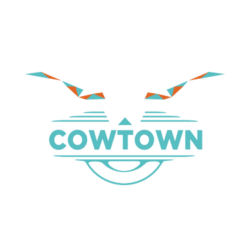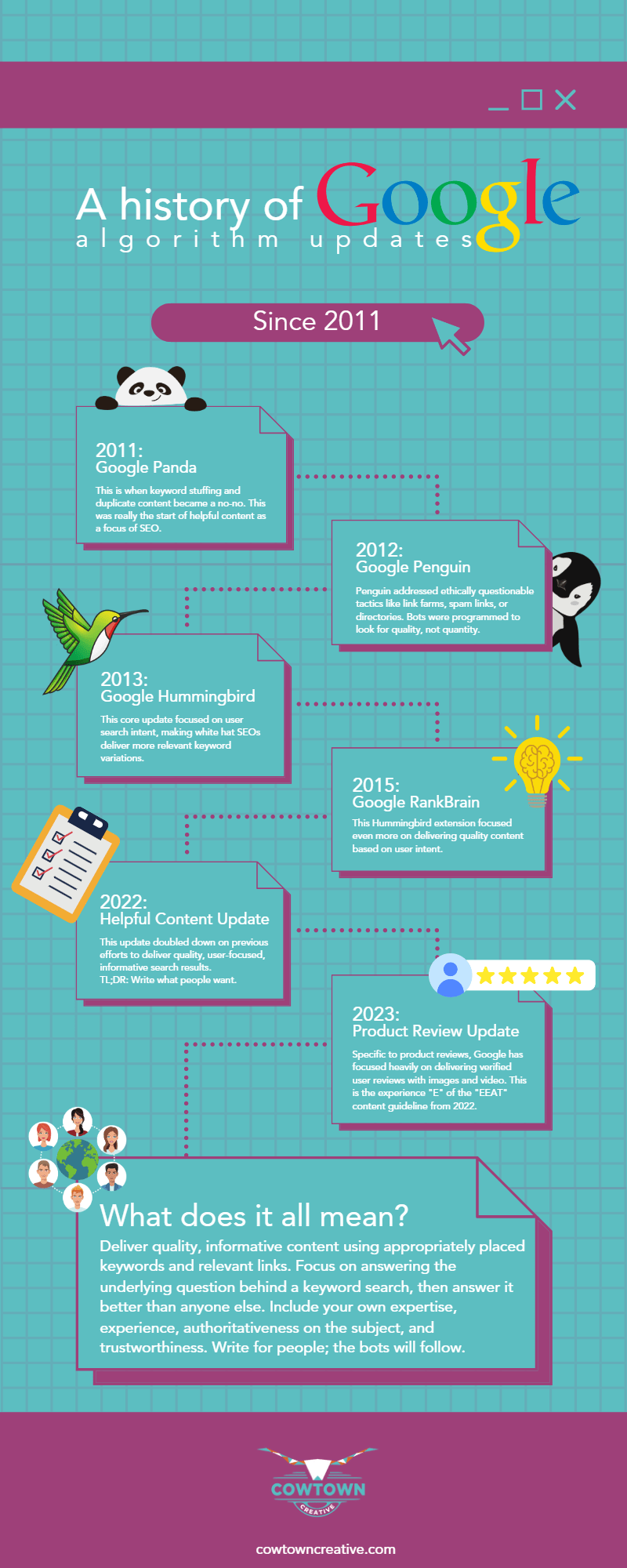It’s time for some plain talk about Fort Worth SEO within the context of the Google search algorithm:
You can do everything “right” and still not be able to rank at the top of page one in Google search. That’s because of two things:
- Your website isn’t optimized; and,
- You’re not creating useful content.
There is no way to fully understand search engine optimization without acknowledging that it’s constantly changing. As a local Fort Worth SEO agency, explaining that to clients has become part of our regular reporting. Keeping up with Google algorithm changes is our job, but it doesn’t have to be yours with a little baseline understanding of how those updates work.
Here’s a quick look at search engine processes and the changes we’ve seen with Google updates over time. There are rules of SEO that don’t change, and are only becoming more important with every update. Skip ahead to the infographic to see a history of algorithm changes and the top ways to stay ahead of them.
What is the Google search algorithm, and why do I care?
Google uses an intricate process to index (scan your website pages) and deliver the best possible search results for a specific search term entered in the Google search bar. The process involves almost daily updates to the search engine’s workhorses: code robots that are programmed to look at specific data in all the websites that exist.
Why do we care so much about Google? It’s the top search engine by far. Google search accounts for nearly 92 percent of ALL internet searches. While other search engines like Bing and Yahoo still exist, they communicate clear optimization expectations that align with Google’s more complex standards.
Optimize your site for Google, and you’ll optimize for all search engines.
How do search engines find my website?
What do the search engine robots look for?

Here’s a quick snapshot of what matters to Google all the time, and what contributes most heavily to your website’s rank, or where it appears in search results:
- Indexability. The bots must be able to “see” the pages in your website. You’d think this would be a no-brainer, but surprisingly, we regularly see websites that are set up to not allow the robots access to their site or specific pages. Sometimes, pages shouldn’t be indexed, but you cannot imagine how many sites don’t rank simply because the web developer has missed a step or coded the site with incorrect instructions. Simply put, these sites tell the robots, “Stop right there! Nothing to see here. Move along.” So, those sites are invisible to people searching for information because the bots don’t deliver them in search results.
- Site speed. Part of what the robots are programmed to do is measure how quickly a website loads. Google wants its top search engine results to deliver a quality user experience (UX), and if a site takes more than 2.5 seconds to load all its graphics and content, it gets moved lower in results.
- Mobile responsiveness. Google bots use a mobile rendering of your site to grade and deliver it in search results. If your website is a hard-coded 1990s edition, it’s not mobile-friendly. You will continue to lose in the search engine results page (SERP) ranking race. Websites typically only last a few years before their code is outdated, so if yours isn’t current, make a new site a priority before you throw money away on ads or any other digital marketing tactic that sends people to your website. Feed the bots first; the people will follow.
- Security. Look up at the URL bar (where the website address is for this site). See that padlock icon? Notice the “https://” before the Cowtown Creative domain name? The “s” means the site is secure, and the padlock is another indicator that the site has a current, verifiable SSL Certificate. SSL stands for Secure Sockets Layer, a digital document that is used to verify the identity of a website and its owner. If your site URL starts with “http://” and doesn’t have a current, correctly assigned SSL Certificate, it will be flagged as unsafe or unsecured, and search engines won’t deliver it to people searching for information. Your site could be seen as a security risk.
- UX (user experience). We’ve grouped a few vital elements under the UX umbrella because they’re all about delivering a positive user experience:
- Your site should be easy to navigate, meaning it should be easy for a visitor to find whatever they’re looking for in three clicks or less.
- The content on every page should incorporate relevant keywords, but also deliver useful information that’s easy to read and understand. Don’t. Keyword. Stuff. It’s rude.
- External and internal links should relate to and provide more information about content on the page.
If your site doesn’t offer these features, visitors won’t stay, and the bots can see how quickly they leave or “bounce.” High bounce rates will get you shoved to the bottom of the search results. No bueno.
Altogether, these five points (and some specific site speed data points that fall under #2 and are included in Google’s Core Web Vitals for ranking websites) make up the foundation of any local Fort Worth SEO work. If the foundation isn’t in good shape, there’s no point in building the rest of the house. Do some basic cleanup first, THEN optimize your site based on what Google bots – and people – want to see.
Google search trends and algorithm updates: A brief timeline
Neil Patel, the worlds foremost expert on SEO, published The Ultimate Google Algorithm Cheat Sheet in May 2023. That inspired this blog post, written from a Fort Worth SEO agency perspective. If you want more detail, head over there and see what Neil has to say.
First, understand how Google releases updates and at what scale:
Algorithm updates happen daily, sometimes multiple times a day. Those changes are small and don’t normally show up as traffic changes in Google Search Console or Google Analytics.
Core updates happen about every six months, and usually take a week or two to start affecting your site analytics. Sometimes, a core update will begin rolling out and we’ll see site traffic changes (dips or spikes) and that’s how we know to look for the core update details. Google isn’t always super transparent about what they’re doing, and when.
Here’s a quick summary infographic of all the algorithms that may have affected your site’s search rankings, followed by what you need to be doing about it.
The upshot of all these changes is that building relevant content is still, and always has been, your top priority once you’ve cleaned up your website. Whether your business caters to consumers or other businesses, people are still at the heart of every decision to choose your business over others.
Whether you’re focusing on local Fort Worth search page results like the coveted Google 3-Pack, you’re looking to reach a different geographic audience, or you’re wanting to cast a wider net, focus on the people who are looking for you.
Fort Worth SEO agency services that get results.
At Cowtown Creative, we deliver monthly digital analysis reports that include website traffic from all sources. When we go over the reports with our clients, we always note when an algorithm change has rolled out and how it may affect traffic. It’s interesting to note that our clients who invest in monthly website maintenance and SEO content don’t see big changes from those Google updates.
The moral of this story? Write for people, and the bots (and top search engine results page rankings) will follow.




